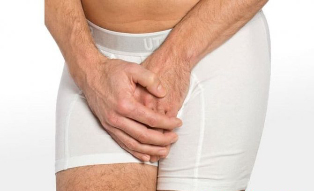
Male prostatitis is inflammation of the male prostate. This is a relatively common disease in men, and it is painful when emptying the bladder (urination) and ejaculation. The doctor distinguishes between acute and chronic prostatitis. Treatment and prognosis depend on the form and cause of prostate inflammation. Read all about prostatitis here.
Prostatitis: description
Prostatitis (prostatitis) is an inflammation of the human prostate. The prostate is located directly below the bladder, about the size of a chestnut. It surrounds the first part of the urethra and extends to the so-called pelvic floor composed of muscle tissue.
The secretions produced by the prostate include PSA (Prostate Specific Antigen) and spermine. PSA thins the ejaculation. Sperm is very important for sperm motility.
Prostatitis is mainly related to severe pain in the perineum and anal area. In addition, symptoms such as frequent urination, pain during urination (urination), and pain during ejaculation may occur during prostate inflammation.
The prostate is relatively common in inflammation. It is estimated that about 15% of men in Germany will experience prostatitis once in their lifetime. The possibility of prostate contraction increases with age. Studies have shown that most cases are between 40 and 50 years old.
Prostatitis Syndrome
At the same time, the medical community has a better understanding of the term prostatitis. In the so-called prostatitis syndrome, some discomfort in a person's pelvic area is summarized, usually for unknown reasons. The term "prostatitis syndrome" summarizes various clinical pictures:
- Acute bacterial prostatitis
- Chronic bacterial prostatitis
- Inflammatory and non-inflammatory syndromes of chronic pelvic inflammatory disease (non-bacterial chronic prostatitis)
- Asymptomatic Prostatitis
Acute and chronic bacterial prostatitis
Acute prostatitis is caused by bacteria (acute bacterial prostatitis). Bacteria are either spread to the prostate through the bloodstream or from a bacterial infection of the bladder or urethra to the prostate. Acute prostatitis is usually a serious general condition, with severe pain during urination, fever and chills. Prostatitis is caused by bacteria, accounting for about 10%.
Chronic prostatitis can develop acutely: if prostatitis is observed for more than three months and the recurring presence of microorganisms in urine (so-called prostate expression) (obtained by massaging prostate fluid) or expression in ejaculation, then this is chronicInflammation. Bacterial prostatitis. It is not as fast as acute prostatitis. Although chronic inflammation of the prostate can cause pain during urination and may produce a sense of pressure in the perineum, the symptoms are usually not as severe as acute prostatitis.
Chronic pelvic pain syndrome (non-bacterial prostatitis)
In most cases of prostate infection, bacteria cannot be detected in urine, prostate or ejaculation to cause disease. The cause of prostatitis is still unclear. Doctors call this chronic pelvic pain syndrome (chronic nonbacterial prostatitis).
However, in this case, white blood cells (white blood cells) are often found to be an expression of inflammation in the prostate (chronic pelvic pain syndrome). To distinguish it, this is another form of the disease in which neither bacteria nor white blood cells are found (non-inflammatory chronic pelvic pain syndrome). Generally, chronic pelvic pain syndrome (non-bacterial prostatitis) is the most common form of prostatitis.
Asymptomatic Prostatitis
In rare cases, asymptomatic prostatitis may occur. In this form of prostatitis, despite the signs of inflammation, there is no pain or other symptoms. For example, as part of a fertility study, asymptomatic prostatitis is often discovered incidentally.
Prostatitis: Symptoms
Prostate inflammation can cause various symptoms of prostatitis. Although the symptoms of acute prostatitis can be very severe and cause severe discomfort, they are usually milder for chronic prostatitis. Not everyone affected does not necessarily have all of these symptoms, and the severity of symptoms may vary from person to person.
Acute prostatitis: symptoms
Acute prostatitis is usually an acute disease, and the patient will have fever and chills. Inflammation of the prostate around the urethra can also cause typical urinary tract symptoms. Urination can cause burning pain (alguria) and significantly reduce urine flow (dysuria) due to swelling of the prostate. Because victims can only excrete a small amount of urine, their frequency of urination is constant, so they must go to the toilet (pollakisuria) frequently. Other symptoms of prostatitis include bladder, pelvic pain and back pain. Pain may also occur during or after ejaculation.
Chronic Prostatitis: Symptoms
Chronic prostatitis is usually not as severe as acute inflammation of the prostate. Usually there are no symptoms such as fever and chills at all. Darkening of ejaculate caused by pressure in the perineum or lower abdomen, blood in semen or blood in urine (ejection) is a typical chronic inflammation of the prostate. Sexual desire and sexual dysfunction are also common chronic symptoms, usually due to pain during or after ejaculation. There is no difference between the symptoms of chronic bacterial and chronic non-bacterial prostatitis (chronic pelvic pain syndrome).
How to identify?

The onset of prostatitis is rarely clearly recognized because sometimes it is asymptomatic, and its symptoms are different for each patient and change over time.
These features include:
- A man has difficulty urinating in the toilet. The glands gradually enlarged and the urethra contracted.
- The patient loses interest in sex. It is more difficult for the penis to wake up when trying to make sexual contact. Orgasm is difficult to achieve, weakly or completely disappear.
- Burning in the urethra, itching in the perineum
- I often want to pee, but I get it bit by bit.
- The semen is released quickly during intercourse, almost no fun.
- General fatigue, depression, irritability, aggressiveness, increased anxiety.
In the morning, one feels overwhelmed and loses the initiative in life.
At the same time, at night, erections and ejaculation sometimes occur spontaneously, regardless of sex.
Observing these phenomena, the patient calmed down and thought that his treatment ability was very good. He believed that the problem was related to his partner and his relationship. He was overcome by depression, which exacerbated the development of the disease.
Incidence rate statistics
Prostatitis is one of the most widespread diseases of the male genitourinary system in the world. According to various sources, this condition is observed in 60-80% of sexually mature men. According to official medical statistics, more than 30% of young people of childbearing age suffer from chronic prostatitis. In about one-third of cases, it occurs in men over 20 and under 40. According to the World Health Organization, urologists will diagnose chronic prostatitis in every tenth of their patients.
Complications of prostatitis
In addition to acute symptoms, prostatitis may also cause complications, complicating the disease process and prolonging the cure period. The most common complication is prostate abscess (especially in acute bacterial prostatitis). Prostatic abscess is a purulent inflammation that usually needs to be opened and emptied through an incision.
As a further complication of prostate inflammation, inflammation can spread to nearby structures, such as the epididymis or testis (epithematitis, orchitis). It is also suspected that chronic prostatitis is related to the development of prostate cancer.
Prostatitis: Causes and Risk Factors
Prostatitis may have many causes. The treatment and prognosis of inflammation depend on the cause of prostatitis.
Bacterial Prostatitis: Causes
Only 10% of prostatitis cases are caused by bacteria in the prostate (bacterial prostatitis). Bacteria can enter the prostate through the blood (blood-producing) or from nearby organs (such as the bladder or urethra), causing inflammation.
E. coli (E. coli) mainly occurs in the human intestine and is the most common cause of prostatitis. Klebsiella, Enterococcus or Mycobacterium can also cause prostatitis. Bacterial prostatitis can also be caused by sexually transmitted diseases, such as chlamydia or trichomoniasis and gonorrhea.
In chronic prostatitis, the bacteria in the prostate gland escape an unclear way of protecting the human immune system. This allows microorganisms to continuously settle in the prostate. Antibiotics in prostate tissue are relatively weak, which may be another reason why bacteria survive in the prostate.
Chronic Pelvic Pain Syndrome: Causes
The exact cause of chronic pelvic pain syndrome is still not fully understood. Scientists have proposed many theories, each of which sounds reasonable, but all of these theories have not yet been clearly proven. In some cases, genetic material from previously unknown microorganisms was found in the pelvis. Therefore, the cause of pelvic pain syndrome may be microorganisms that are still not cultured in the laboratory and therefore cannot be detected.
Another possible cause of chronic pelvic pain syndrome is bladder emptying disorder. Due to incomplete drainage, the bladder increases in size, thereby compressing the prostate. This pressure will eventually damage the prostate tissue and cause inflammation.
Another possible cause is that inflammation of the bladder tissue may spread to the prostate. Nerve stimulation around the prostate can also cause pain that is incorrectly attributed to the prostate.
Finally, an overactive immune system or the wrong direction can also cause chronic pelvic pain syndrome.
However, in many cases, the cause of chronic pelvic pain cannot be clearly proven. Then, the doctor talked about idiopathic prostatitis.
Anatomical reasons
In rare cases, prostatitis is caused by urinary tract stricture. If the urinary tract narrows, urine will accumulate, and if urine enters the prostate, it can also cause inflammation. This reduction may be caused by tumors or so-called prostate stones.
Doctors also suspect that pelvic floor muscle dysfunction may lead to the development of prostatitis.
Psychological reasons
Recently, more and more psychological reasons have caused the discussion of prostatitis. In particular, in non-inflammatory chronic pelvic pain syndrome, it may be a mental trigger. The exact mechanism is still unknown.
Prostatitis risk factors

Some men are particularly susceptible to prostate infection. These include, for example, men with compromised or suppressed immune systems (for example, receiving medications, immunosuppressive treatments). In addition, underlying diseases such as diabetes may also lead to the development of prostatitis: elevated blood sugar in diabetic patients usually leads to increased urine sugar. Urine is rich in sugar, which can provide good growth conditions for bacteria and make it easier to develop urinary tract infections. In addition, the immune system of diabetes is weakened.
Another risk factor for prostatitis is the bladder catheter. Inserting the catheter into the urethra and passing it through the urethra can cause fine tears in the urethra and damage the prostate. In addition, like any foreign body, bacteria can also deposit on the bladder and form a so-called biofilm. As a result, bacteria can travel up the urethra to the bladder and cause prostate infection.
Prostatitis: examination and diagnosis
In the case of prostate problems, the family doctor or urologist is the right contact person. The general practitioner can accept the medical history (historical record), but if prostatitis is suspected, he will refer you to a urologist. This will perform a physical examination. If prostatitis is suspected, this is usually a so-called digital rectal exam. However, this study did not provide clear evidence of prostate inflammation, but only confirmed the suspicion. Laboratory tests can be done to detect bacterial prostatitis. If no specific cause is found, treatment should be performed if prostatitis is reasonably suspected.
Case History
Typical problems when recording medical history (forgetting) can be:
- Do you have pain when urinating?
- Where do you feel the pain?
- Did you hurt your back?
- Have you noticed a change in ejaculation?
Digital rectal examination
Since the prostate is directly adjacent to the rectum, it can be palpated along the rectum. This digital rectal examination is performed in an outpatient setting without anesthesia and is usually painless. Ask the patient to lie down with their legs bent. Then, the doctor uses a lubricant to slowly insert the finger into the anus and scans the prostate and surrounding organs (palpation). He checked the size and sensitivity of the prostate: the inflamed prostate was greatly swollen and very sensitive to pain.
Laboratory inspection
In most cases, urinalysis is required to identify possible pathogens. The standard method is the so-called four-cup sample. Here, Ersturin, Mittelstrahlurin, Prostataexprimat and Urin were tested after prostate massage. As Prostateexprimat is called, doctors call prostate secretions. This is done by the doctor by applying light pressure to the prostate (for example, by palpation). You can also check for pathogens and signs of inflammation in your ejaculation.
Further research
An ultrasound scan (ultrasound) of the rectum can be performed to pinpoint exactly where the inflammation is and how far it has spread. The important goal of the study is to rule out other diseases with similar symptoms (differential diagnosis).
Perform urine flow measurement (urinary flow meter) to rule out the existing urine flow problem caused by urethral stricture. The patient urinates in a special funnel that measures the amount of urine per unit time. A normal urine flow rate of 15 to 50 milliliters per second, and a urine flow rate of 10 milliliters per second or less, is likely to cause urethral obstruction.
Prostatitis: PSA measurement
Elevated blood PSA (prostate specific antigen) levels are usually considered an indicator of prostate cancer. However, even with prostatitis, the PSA level in the blood can be significantly increased. If the reading is significantly higher, tissue sampling (biopsy) is usually done in the laboratory and checked to safely rule out prostate cancer.
Prostatitis: Treatment
Like other diseases, the treatment and duration of prostatitis depends on the cause.
Drugs
Acute bacterial prostatitis is treated with antibiotics. In mild cases, the antibiotic dose is sufficient for about ten days. For chronic prostatitis, the drug should be taken for a longer period of time (approximately four to six months). Even if the symptoms have subsided, you should continue to use antibiotics as directed by your doctor in any case. This prevents recurrence and reduces the possibility of recurrence.
Asymptomatic prostatitis can also be treated with antibiotics.
If there is chronic nonbacterial prostatitis (chronic pelvic pain syndrome), antibiotic treatment is usually ineffective. In chronic pelvic pain inflammation syndrome, although there is no evidence of the pathogen, antibiotic testing is done because it can sometimes improve the condition. However, antibiotic therapy is not recommended for non-inflammatory chronic pelvic pain syndrome.
Other treatments for chronic non-bacterial prostatitis are so-called 5α-reductase inhibitors and herbal medicines. If improvement cannot be achieved, medical treatment will be supplemented by physical therapy. It recommends physical therapy, pelvic floor exercises or regular prostate massage. In addition, microwave heat therapy can stimulate tissues to increase blood flow and relieve pain.
In addition, symptomatic treatment can help relieve the acute symptoms of prostate infection. Analgesics can be used to treat severe pain. In addition, heating pads and heating pads on the back or lower abdomen can also help relax the muscles. It usually relieves the pain caused by inflammation of the prostate.
Home remedies, such as processing rye or eating pumpkin seeds in the shell, can also help resolve the symptoms of prostatitis. Other tips include regular pelvic floor exercises, no sharp bicycle saddles, no beer, meat, fat, and sugar.
Complications treatment
If a large amount of urine outflow obstruction occurs in this situation, a prostatectomy may be helpful, because residual urine always causes a high risk of urinary tract infection.
If inflammation secretes pus (abscess) in the prostate, it should be emptied through the incision. The entry route is usually the rectum

























